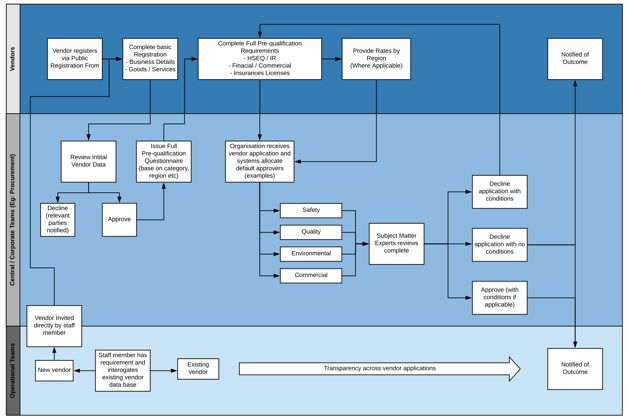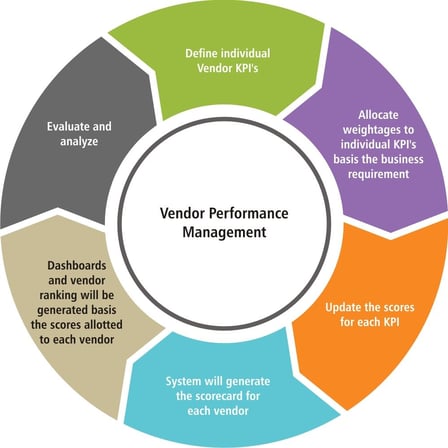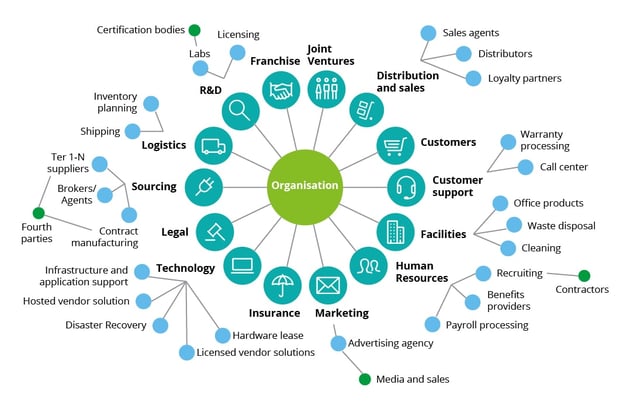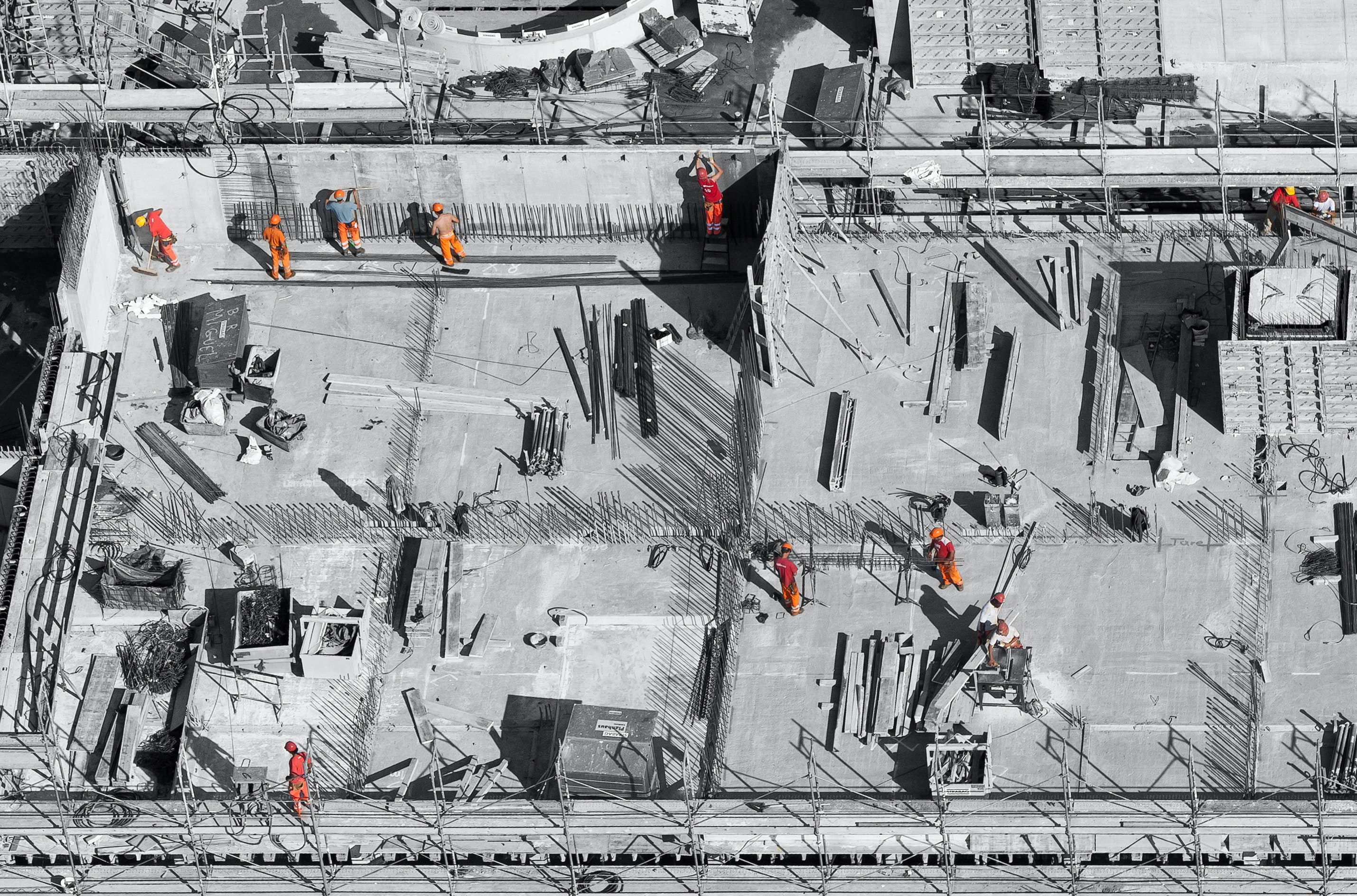The concept of engaging external parties to do work for your business is probably as old as the concept of business itself. The inherent us vs. them relationship means there are often procedures, documents, and checkpoints, to make sure the vendor does things in your best interest.
High-risk supply chains, where the majority of work is subcontracted to third parties (e.g., construction, mining, utilities), necessitate a robust vendor management strategy. This approach ensures that your vendors are aligned with your business goals and that potential vendor risk is minimised throughout the long run.
What is Vendor Management?
Let’s take a look at some definitions.
“Vendor management helps organisations take third-party vendor relationships from a passive business transaction to a proactive collaborative partnership.”
This definition from CIO accurately captures the transformation of a vendor relationship and gives us the overall “vision” for a vendor management program.
Digging more into the “how”, this definition from Gartner also adds that it’s meant to be a life cycle:
“Vendor management is a discipline that enables organisations to control costs, drive service excellence and mitigate risks to gain increased value from their vendors throughout the deal life cycle.”
The different nuances of vendor management
Looking at vendor relationships from a life cycle’s point of view, we can broadly see vendor management activities through two lenses as follows.
The trust building lens
It might sound adversarial, but when a new supplier is about to enter your supply chain, that carries a degree of risk. At this stage, most interactions are about assurance, governance, and minimising risks when selecting vendors.
Vendor compliance management then comes in, with prequalification (for potential vendors), onboarding and requalification (for current vendors).
The influence might tilt more towards the organisation’s side –because after all, vendors are trying to win trust and ongoing work. A counter-argument though, making your vendors jump through hoops in the name of compliance is not a good long-term strategy. Trust has to be a two-way street.
 An example vendor onboarding process in Felix Vendor Management module
An example vendor onboarding process in Felix Vendor Management module
The next aspect is to do with performance management.
“If you can't measure it, you can’t manage it”.
Measuring and capturing vendor performance through feedback loops is essential to ensure ongoing value for your organisation. Effective vendor performance management fosters a closed-loop feedback system between you and your vendors, as well as with internal stakeholders. This allows for continuous improvement and ensures that vendors are consistently meeting your expectations.
 An example vendor performance management framework
An example vendor performance management framework
Closely linked to performance management is contract management. Thorough contract negotiation that addresses potential issues like change requests, dispute resolution, and liabilities minimises the risk of conflict down the line. A well-defined vendor contract with clear contract terms protects both your organisation and your vendors, ensuring a smooth working relationship.
The collaborative lens
By the nature of subcontracting work to third parties who provide goods and services, collaboration might not be the first word that comes to mind.
But it’s worth noting what great supplier management can do – as in the definition outlined earlier in this post, it’s about turning “a passive business transaction to a proactive collaborative partnership.”
This involves identifying common business goals and fostering a spirit of partnership. Building strong supplier relationships can be achieved through empathy and a willingness to "sell" your organisation's vision to them. If you’re interested in exploring supplier collaboration as a concept, this McKinsey article provides some good background context.
Building on that, “emotional intelligence” could be an important attribute for anyone responsible for vendor management.
Often, organisations “dictate” their goals to vendors, ask for price reductions, extended payment terms in vendor contracts etc. But this is not a sign of a collaborative strategic partnership. Some wise words from the article:
“Suppliers would continue smooth operations with clients that they have a collaborative relationship with. Hence, my advice to my dear colleagues is to be adaptable and flexible. The socio-political situations change in a matter of hours. It is important that we are open to change, based on the business needs. Do not hide behind processes and policies.”
Challenges and hidden opportunities
The premise of vendor management is not new. But with all that’s happened in the past year, the imperative for organisations to get a grip on vendor relationships has become more pronounced.
Renewed focus on risk
For high risk supply chains, vendors and third-party service providers are your “extended enterprise.” Yet quite often, it’s not subject to the same rigour of risk management as your internal workforce.
 The “extended enterprise”. Source: Deloitte
The “extended enterprise”. Source: Deloitte
Stats such as this has prompted the need to strengthen supplier management capabilities:
“90% do not recognise the need or have appropriate knowledge, visibility or resources to monitor subcontractors.” (Deloitte)
Additionally, the pandemic has caused shifts and challenges in the global supply chain. Organisations might find themselves dealing with financially struggling suppliers, temporary shortages and disruptions to operations.
Efficiency
Imagine a reaction to the renewed focus on risk above is to go and requalify existing vendors and prequalify new vendors on a mass scale.
Imagine also that the current method to handle all those risk assessment processes is via spreadsheet and email.
The labour-intensive processes around prequalification, onboarding and requalification can lead to strains on relationships, especially if there is a lot of double handling, misinformation or back-and-forths.
With or without the imaginary knee-jerk reaction above, any efficiency gain in a key business process would result in cost savings in the long run – for both you and your vendors.
New technologies are constantly emerging that can improve the efficiency and effectiveness of vendor management. Vendor management software can automate tasks, streamline workflows, and provide valuable insights into vendor performance
Innovation
Top-performing vendors can be a source of new ideas and innovative solutions. By fostering a collaborative environment, you can tap into their expertise to develop new products and services, improve efficiency, and gain a competitive edge.
Sustainability
Many organisations are placing greater emphasis on ESG. Vendor management can play a role in ensuring that your supply chain aligns with your sustainability goals. This may involve working with vendors who share your commitment to sustainability or implementing programs to reduce the environmental impact of your sourcing practices.
Grow revenue
Tightening margins, reduced productivity and increased costs following COVID-19 mean many are forced to do more with less.
The power lies in the knowledge you have about your vendors, who the strategic and top performing vendors are. Now is the time to strengthen those relationships and align on key business objectives for the recovery period.
Again, do you and other internal stakeholders know who those suppliers are?
---
Stay tuned for the next instalment of the series, where we’ll dive into what to look for in a vendor management system.
----
Interested in an industry standard prequalification framework that’s built into a vendor management solution? Learn more about Vendor Optiqual® here.

Recent Articles
2025 in review: Milestones, insights and achievements
2025 – a year of that brought meaningful developments for Felix as we continue to address the evolving needs of organisations navigating complex supply-chain environments.
Top 10 reasons for a centralised vendor database
As organisations grow, so does the complexity of managing vendor relationships. Many still rely on spreadsheets or siloed systems, which can lead to inefficiencies, data inconsistencies, and compliance risks. A centralised vendor database offers a smarter, more scalable solution that brings structure, visibility, and control to procurement operations.
Here are the top 10 reasons why centralising your vendor data is a strategic move.
Five ways poor contract storage could be costing your organisation money
Contracts are the backbone of every business relationship – legally binding documents that define expectations, responsibilities, and value.
But what if the way your organisation stores those contracts is quietly costing you money?
Let's stay in touch
Get the monthly dose of supply chain, procurement and technology insights with the Felix newsletter.






